The recently published Gallery | Health and healing introduced us to the world of medicine, including Asklepios and Hygieia, and some Homeric passages.
This post explores a few more references in ancient Greek texts to healers, doctors, drugs, and health, looking at a few passages on Cheiron and his teachings; and on the cult of Asklepios.
Cheiron and his teachings
Cheiron is a centaur and healer who teaches various heroes the healing arts. It might strike us as unusual that a centaur should be associated with healing; most centaurs, half-horse and half-human, are “wild, lawless, and inhospitable beings, the slaves of their animal passions”[1] Cheiron, however, is described in Homeric epic as “most righteous of all the centaurs.” (Iliad 11.832)[2]
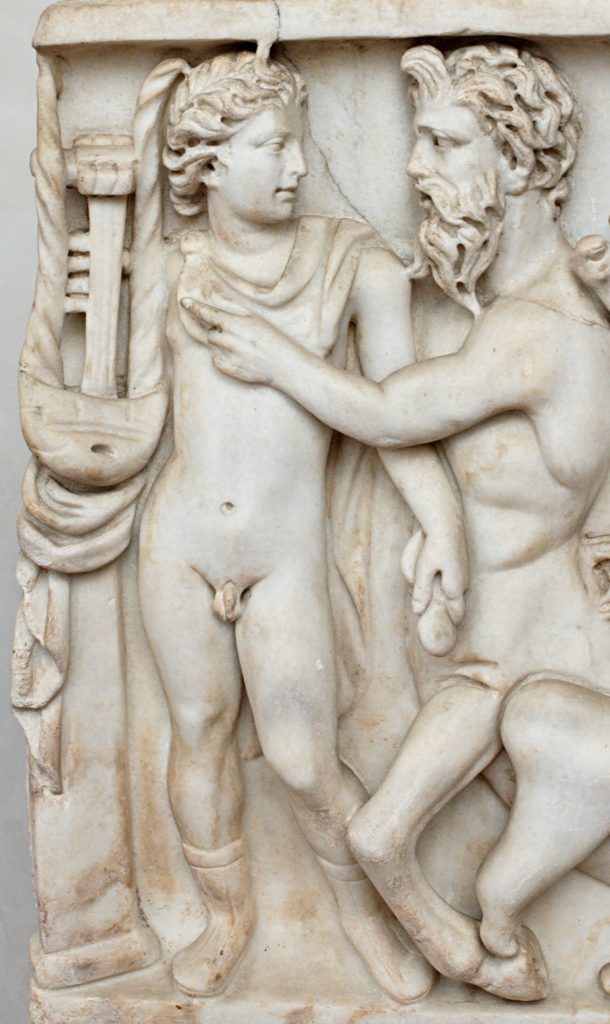
He was the son of Kronos (in the shape of a stallion) and Philyra; one version of the story appears in Apollonius Rhodius[3]. Nothing in his ancestry seems to suggest healing ability; however Apollo taught him, and the skills of medicine, hunting, music, and prophecy are all associated with both Apollo and with Cheiron; in fact Apollo can bring sudden disease or plague with his arrows, which may seem to contradict his medical ability, but perhaps, as with drugs (pharmaka), he can have both a beneficial or baneful effect. The centaur Cheiron in his turn teaches many of the major heroes of ancient Greek mythology.
In Classics@ 15: A Concise Inventory of Greek Etymologies, Laura Massetti discusses the forms and meanings of his name.
If Kheirōn (Χείρων) is the original form, the name may be related to Greek kheir (χείρ) ‘hand’ (Kretschmer 1919:58–62), meaning ‘the one who has a special hand’. …
Without any doubt, ancient literary sources connected Chiron with the ‘healing hand’ and the ‘healing practice’ (kheirourgiā). Indeed, Chiron mentors a number of young heroes connected with both hunting and healing, such as Jason, Aristaeus, Asclepius, and Achilles. Specifically, Pindar says that Chiron ‘taught’ his students ‘the gentle-handed province of medicines’ (Χίρων … τὸν φαρμάκων δίδαξε μαλακόχειρα νόμον, Pindar Nemean 3.53–55). Additionally, the name of Jason (Ἰάσων), one of Chiron’s pupils, actually means ‘healer’ (compare Greek ἰάομαι ‘to treat’, ἰατήρ ‘physician’).[4]
Most of the passages about Cheiron refer to his teaching rather than to his being a practitioner. For example, Pindar describes how Apollo brought Asklepios to Cheiron to learn healing:
he bore the child away and gave him to the Magnesian Centaur to teach him to heal many painful [polu-pēmōn] diseases [nosoi] for men. And those who came to him afflicted with congenital sores [autophútos], or with their limbs wounded [titrṓskein] by gray bronze or by a far-hurled stone, [50] or with their bodies wasting away from summer’s fire or winter’s cold, he released and delivered [exagein] all of them from their different pains [ákhos], tending some of them with gentle [malakai] incantations [epaoidai], others with soothing [prosanḗ] potions, or by wrapping remedies [pharmaka] all around their limbs, and others he set upright with surgery [tomai].
Pindar Pythian 3.45–53, adapted from translation by Diane Arnson Svarlien[5]
This passage provides an interesting list of ailments, and of the means of healing. In particular, and perhaps significantly for Pindar as a poet, one of these methods is by incantation—the power of words, which also ties in with the Socrates passage. Gildersleeve’s notes for this passage[6] provide some more information about some of the terms:
θερινῷ πυρί [“summer’s fire”]: Sunstroke. Perh. “Summer fever.”
ἔξαγεν [“delivered”]: “Brought out,” still used by the profession
μαλακαῖς ἐπαοιδαῖς [“gentle incantations”] Incantations were a regular part of physic among the Greek medicine-men. The order is the order of severity.
τομή is the regular surgical word for our “knife”
I found the “gentle/soothing incantations” particularly interesting. When Odysseus was injured by the boar on Mount Parnassus:
The sons of Autolykos busied themselves with the carcass of the boar, and bound flawless godlike Odysseus’ wound [ōteilḗ]; then, after saying a spell [ep-aoidḗ] to stop the dark blood [haîma], they went home as fast as they could. But when Autolykos and his sons [460] had thoroughly healed [iâsthai] Odysseus, they made him some splendid presents, and sent him back to Ithaca with much mutual good will [khaírein].
Odyssey 19.455–462, adapted from Sourcebook[7]
They use a form of song or spell to heal his injury, rather than dressing the wound or applying herbs.
Among the pupils of Cheiron was Achilles, and we see him in Iliad 9:
186 and they found Achilles diverting [térpesthai] his heart [phrēn] as he was playing on a clear-sounding lyre [phorminx], … 189 and he was now diverting [térpein] his heart [thūmos] with it as he was singing [aeidein] the glories of men [klea andrōn]. [190] Patroklos was the only other person there. He [= Patroklos] sat in silence, facing him [= Achilles], 191 and waiting for the Aeacid [= Achilles] to leave off singing [aeidein].
Iliad 9.186–191, adapted from Sourcebook.[8]
Although the verb [térpein] has a sense of enjoyment, it can also provide a relief (for example when ‘having one’s fill’ of weeping), and he is singing to take care of his mental and emotional state. And the other person present awaiting his turn is Patroklos, Achilles’ therapōn, a word which itself has a connection with being a “ritual substitute,” but also one who can take care of or cure someone, summarized by Gregory Nagy,
6§56. By now we can see that therapeuein in the sense of ‘maintain the well-being of, take care of, care for’ and in the special sense of ‘heal, cure’ is in fact related to the idea of a ritual substitute who maintains the well-being of someone superior whom he serves by standing ready to die for that special someone. That is the therapeutic function, as it were, of the therapōn.”[9]
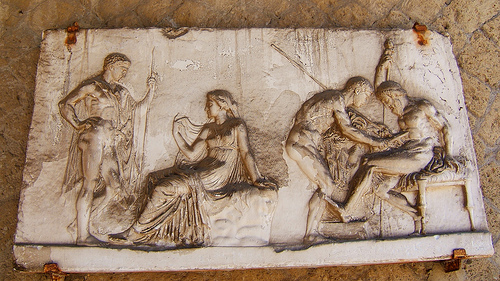
Cheiron gave to Peleus the great ash spear which then passed to Achilles, and which only he could lift (Iliad 16.140–144). Usually, of course, he used it to kill his opponents, or at least injure them. However, there is a tradition that Achilles injured Telephos at Mysia on the way to Troy, then later he used it to heal Telephos with the same spear, so it seems the diverse skills that Cheiron taught may have been more closely connected than they first seem, and in particular there is a relationship between injuring and healing.
Now Telephos son of Herakles, was king of the Mysians, and seeing the country pillaged, he armed the Mysians, chased the Greeks in a crowd to the ships, and killed many, among them Thersander, son of Polyneikes, who had made a stand. But when Achilles rushed at him, Telephos did not abide the onset and was pursued, and in the pursuit he was entangled in a vine-branch and wounded [titrōskein] with a spear in the thigh. …
But Telephos, because his wound [traûma] was unhealed [aníaton], and Apollo had told him that there would be a cure [therapeía] when the one who wounded [titrōskein] him should turn physician [iatrós], came from Mysia to Argos, clad in rags, and begged the help of Achilles, promising to show the course to steer for Troy. So Achilles healed [therapeúein] him by scraping off the rust of his Pelian spear. Accordingly, on being healed [therapeúein], Telephos showed the course to steer, and the accuracy of his information was confirmed by Kalkhas by means of his own art of divination [mantikós].
Apollodorus, Epitome 3.17, 3.20, adapted from translation by J.G. Frazer[10]
Asklepios and his cult
This hero was the son of Apollo, and was worshipped as a cult hero with healing powers and later as a god.
On his deathbed, as his final words Socrates instructs Crito, one of his followers, “Crito, I owe the sacrifice of a rooster to Asklepios; will you pay that debt and not neglect to do so?” Gregory Nagy explains this:
After sacrificing a rooster at day’s end, sacrificers will sleep the sleep of incubation and then, the morning after the sacrifice, they will wake up to hear other roosters crowing. So, Asklepios is the model for keeping the voice of the rooster alive. And, for Socrates, Asklepios can become the model for keeping the word alive.
H24H 24§46[11]
Pausanias describes the precinct at Epidauros, and one of the stories associated with Asklepios:
Inside the enclosure [peribolos] are slabs [stēlai]. There used to be many more of these in ancient times, but in my time there were only six surviving. On these slabs are inscriptions recording the names of men and women who were healed [akeîsthai] by Asklepios, including details about the kinds of illness [nósēma] experienced [noseîn] by each one of them—and about how each one of them was healed [iâsthai]. And they are all written in the Dorian dialect. |2.27.4 Standing apart from these slabs is one particularly ancient one, which says that Hippolytus dedicated to the god [theos] forty horses. What the inscription on this slab says is in conformity with what is said by the people of Aricia: according to them, after Hippolytus died as a result of the curses [ārai] hurled at him by Theseus, Asklepios resurrected [an-histanai] him.
Pausanias 2.27.3-4, adapted from Pausanias Reader[12]
Gregory Nagy discusses how this act of Asklepios had consequences:
Zeus incinerated Asklepios with his divine thunderbolt, and he did so precisely because this hero had used his extraordinary skills as a physician to resurrect Hippolytus after that hero’s death (scholia for Pindar Pythian 3.54). This version of the myth seems to be quite ancient, datable at least as far back as the sixth century BCE.
H24H 20§30[13]
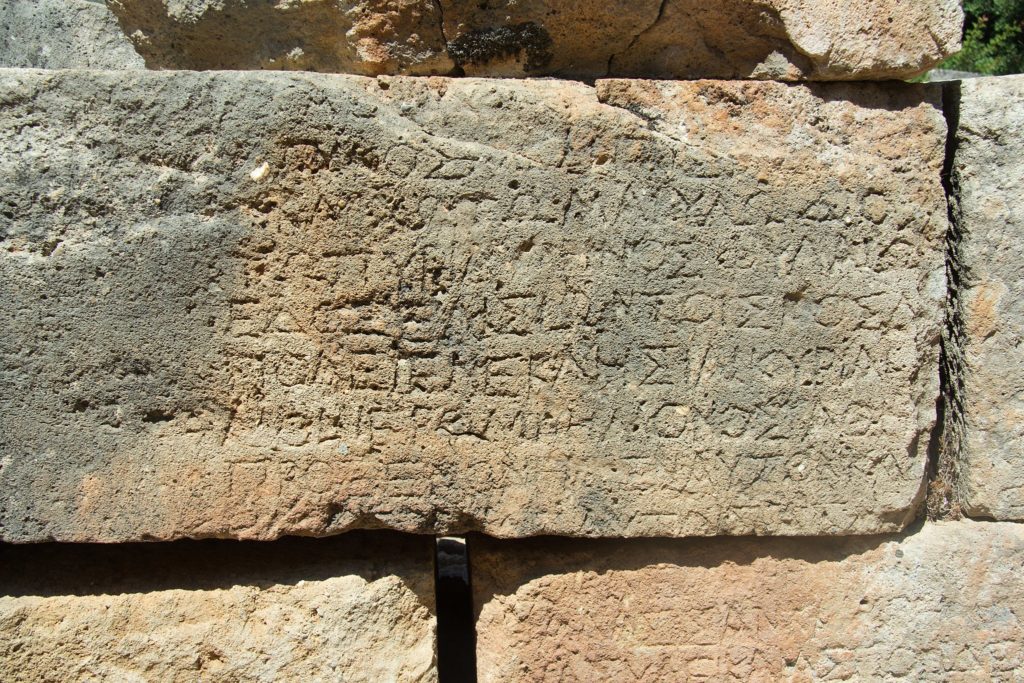
Nagy points out that this type of death itself can lead to immortalization, and describes how the cult of Asklepios spread:
20§32. The earliest attested phases of the cult of Asklepios, localized in Epidaurus, can be dated as far back as the sixth century BCE, and the cult then spread to places like Trozen and Athens in the fifth century. By the time of Pausanias, in the second century CE, the cult had spread even farther, including places like Pergamon, Smyrna, and Cyrene (2.26.8-9). Moreover, as time went by, “Asklepios seems to have made a habit of supplanting local heroes [who also had] healing powers.” … And, in the process, Asklepios became less and less of a hero and more and more of a god. … by the time we reach this era, the cult of this Asklepios had become so widespread—and commensurately elevated—that people could think of him as a god who had always been a god. And that is precisely how Pausanias thought of Asklepios (2.26.10).
There is a short Homeric Hymn (16) dedicated to Asklepios. In their Commentary, Allen and Sikes (1904) say, “There are no data for determining the place of composition, but the antiquity of the hymn is proved by the citation of 1–3 in the scholia on Pindar Pythian 3.14”[14] Most of the Homeric Hymns are dedicated to gods, and here Asklepios is being invoked in a similar way.
I begin to sing of the healer [iatḗr] of diseases [nósoi] Asklepios,
the son of Apollo, and whom radiant Korōnís bore
in the Dotian plain, (Korōnís) daughter of king Phlegyas,
as a great source-of-joy [khárma] for mankind, a soother [thelktḗr] of dire pains [odúnai].
And so hail-and-take-pleasure [khaire], lord: and I appeal to you with song.Homeric Hymn to Asklepios[15]
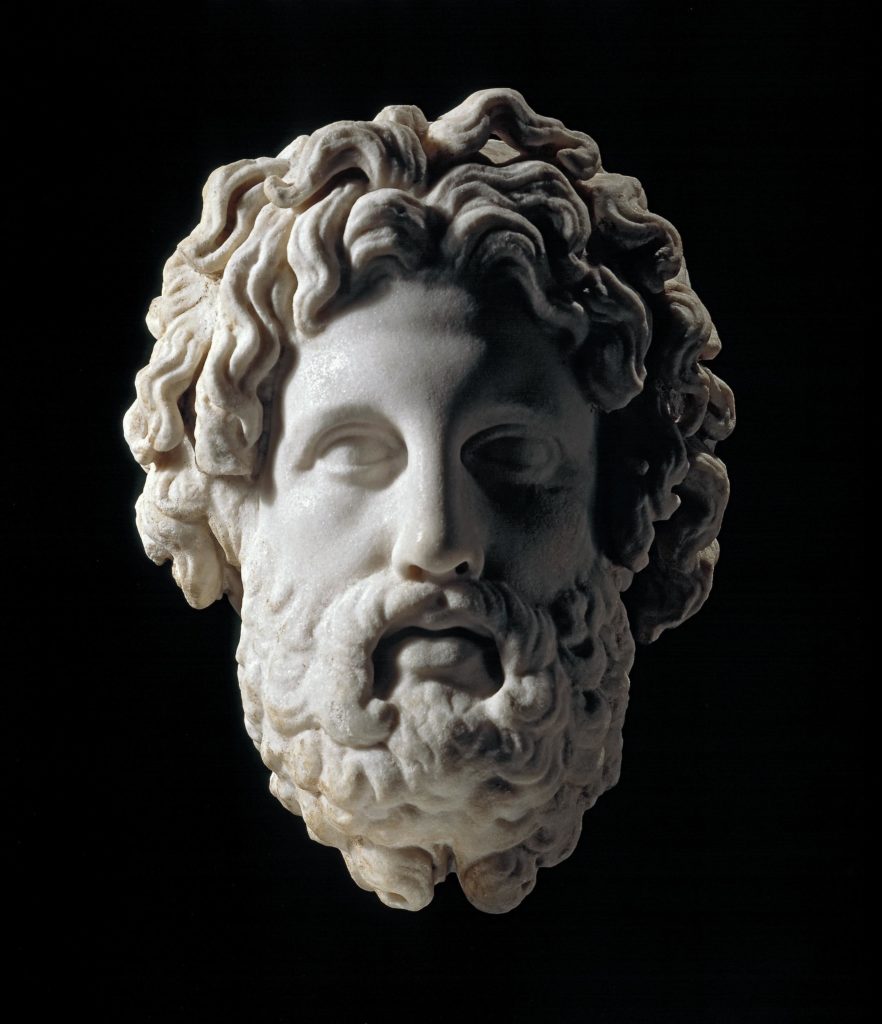
There is also an Orphic Hymn (67) to Asklepios. According to the introductory notes to the translation by Thomas Taylor at theoi.com, these hymns are “are a collection of 87 short religious poems composed in either the late Hellenistic (C3rd or C2nd B.C.) or early Roman (C1st to C2nd A.D.) era. They are based on the beliefs of Orphism, a mystery cult or religious philosophy which claimed descent from the teachings of the mythical hero Orpheus.”[16]
To Asklepios, Fumigation from Manna.
Asklepios, healer [iatḗr] of all, master Paian (Paean); charming away [thelgein] much-suffering [polu-algea] pains [pHma] of diseases [nousoi] of mankind. Soothing-by-gifts [ēpio-dōros], strong, may you come restoring health [hugíeia], and making an end of harsh [khalepoi] diseases [nousoi] of death and doom. All-flourishing youth, warding-off-ill [apalexikakos], of blessed fate [= olbios + moira], strong splendidly-honored offspring of Phoebus Apollo, foe [ekhthros] of diseases [nosoi], having blameless Hygieia as wife, come, blessed one [makar], savior [sōtēr], grant a good [esthlos] end [telos] to life.
Orphic Hymn to Asklepios[17]
Other sources have Hygieia as the daughter of Asklepios.
Both hymns make an invocation or call upon Asklepios and refer to his abilities. They would have been performed on a ritual occasion, as Gregory Nagy comments:
In a hymn, the invoked divinity who presides over a given festival is the subject of the hymn. In the grammar of the Homeric Hymns, for example, the divinity who figures as the subject of any hymn is normally the grammatical object of the verb of singing the hymn …. In the logic of the Homeric Hymns, the divinity that presides over the occasion of performance becomes continuous with the occasion and thus becomes the occasion.”[18]
One might imagine that in hymns to Asklepios one such occasion would be when a supplicant required healing, and another occasion might have been after a successful outcome for someone who might be making an offering in gratitude.
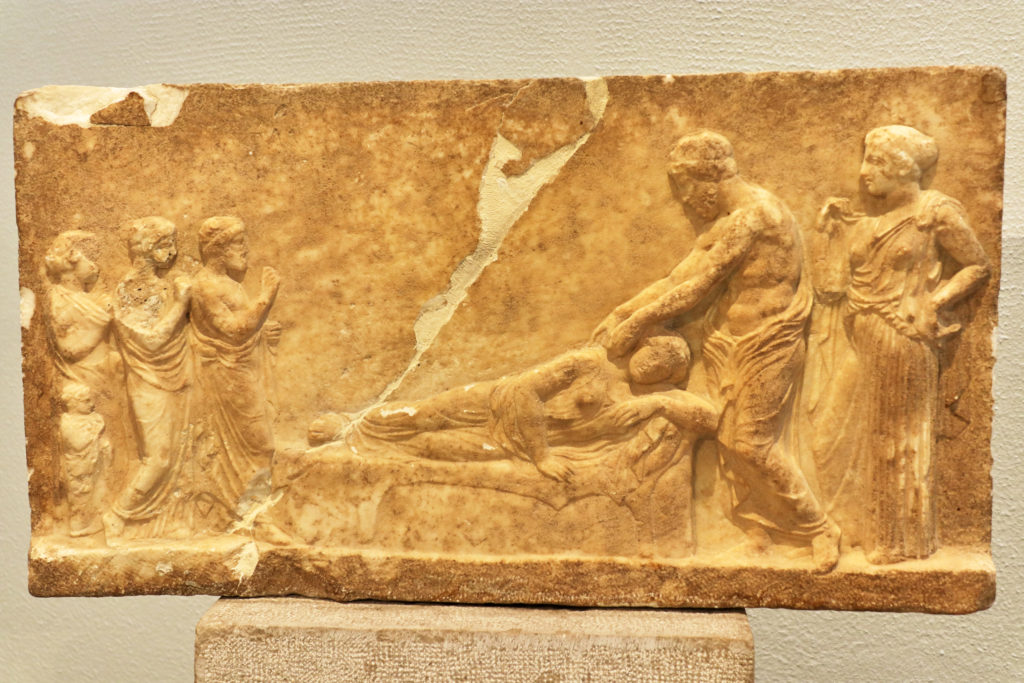
Coming back to the variety of arts that seem to be involved in healing, as taught by Cheiron, Flavius Philostratus in the 1st/2nd century CE provides evidence that divination was considered part of the art:
Iarkhas led back the argument to the subject of divination [mantikós] and among the many blessings [agathá] which that art had conferred upon mankind, he declared the gift of healing [iatrikós] to be the most important. ‘For,’ said he, ‘the wise [sophói] Asklepiades would have never attained to this branch of science [epistḗmē], if Asklepios had not been the son of Apollo; and as such had not in accordance with the latter’s responses and oracles [manteíai] concocted and adapted different drugs [phármaka] to different diseases [nósoi]; these he not only handed on to his own sons, but he taught his companions what herbs must be applied to running [hugrá] wounds [hélkea], and what to inflamed [aukhmērá] and dry [xērá] wounds, and in what doses to administer liquid drugs [phármaka] for drinking by means of which dropsical [húderoi] patients are drained and bleeding [haîma] is checked, and diseases of decay [phthóai] and the cavities [koîla] due to their ravages are put an end to. And who,’ he said, ‘can deprive the art of divination [mantikḗ] of the credit of discovering simples [ákē] which heal the bites [iobóloi] of venomous creatures, and in particular of using the virus [iobóloi] itself as a cure for many diseases [nosḗmata]? For I do not think that men without the forecasts of a prophetic wisdom [sophíā] would ever have ventured to mingle with medicines [phármaka] that save life [sṓzein] these most deadly of poisons.’
Flavius Philostratus Life of Apollonius 3.14, adapted from translation by F.C. Conybeare[19]
This text, later than that of Hippocrates, ascribes the arts of prophecy and divination to successful healing, perhaps in keeping with the continued cult of Asklepios. Yet alongside this, the observational approach of Hippocrates and his followers was paving the way to a more scientific approach to medicine.
Further discussion
This post includes only a few of the passages or references to Cheiron and his pupils, and to Asklepios and his cult. Please join me in the forum to discuss these and to share other examples. If you are able to read the Greek for any primary sources, do they use any similar vocabulary or phrases? What other mythological references have you come across to Cheiron’s teaching, or to his pupils, and how they applied their learning? Have you found other stories about Asklepios’ life or healing abilities? Are there other situations where injury and cure are related? Have any of you visited Epidauros or any other sites where there was a cult of Asklepios?
Selected vocabulary
Glosses are based on LSJ[20] (online at Perseus) unless otherwise noted.
akeîsthai ἀκεῖσθαι heal, cure; staunch; mend, repair; apply a remedy
epaoidḗ [ἐπ-αοιδή] incantation, spell
epistḗmē [ἐπιστήμη] skill, scientific knowledge
haîma [αἷμα] blood
iâsthai [ἰᾶσθαι] to heal, cure, treat
iatḗr [ἰατήρ] healer, surgeon
iatrós [ἰατρός] one who heals, physician, surgeon
iobólos [ἰοβόλος] shooting arrows; venomous, poisonous
malakós [μαλακός] soft, gentle, mild
noseîn [νοσεῖν] be sick, ail, suffer
nósēma [νόσημα] disease, affliction, disordet
nósos/noûsos [νόσος/νοῦσος] sickness, disease, plague; distress, anguish
odúnē [ὀδύνη] pain, of mind or body
ōteilḗ [ὠτειλή] wound, mark of a wound
phármakon [φάρμακον] drug; healing remedy, medicine, cure; potion, charm, spell
phthóē [φθόη] decay, empyema
póa [πόα] herb
polu-pēmōn [πολυπήμων] causing manifold woe, baneful
prosanḗs/prosēnḗs [προσανής/προσηνής] soft, gentle, kindly
thelgein [θέλγειν] to charm, enchant, bewitch, beguile
thelktḗr [θελκτήρ] soother, charmer
therapeúein [θεραπεύειν] to attend, take care of, do service, treat medicinally
titrṓskein [τιτρώσκειν] to wound, injure
Notes
1 Description from entry on “Centaur” at Encyclopedia Britannica
2 Sourcebook: The Ancient Greek Hero in 24 Hours Sourcebook: Sourcebook of Original Greek Texts Translated into English. Gregory Nagy. 2013. Updated 2020-12-15.
Homeric Iliad. Translated by Samuel Butler. Revised by Soo-Young Kim, Kelly McCray, Gregory Nagy, and Timothy Power. Online at the Center for Hellenic Studies
3 Apollonius Rhodius Argonautica 2.1231–1241. Translated with an Introduction, Commentary, and Glossary by Peter Green. 2007. University of California Press.
4 Massetti, Laura. 2018.05.29. Entry for “Kheirōn (Χείρων, Χίρων, Χέρρων)” in A Concise Inventory of Greek Etymologies.
https://classics-at.chs.harvard.edu/volume/classics15-a-concise-inventory-of-greek-etymology/
5 English: Odes. Pindar. Diane Arnson Svarlien. 1990. Online at Perseus.
Greek: Pindar. The Odes of Pindar including the Principal Fragments with an Introduction and an English Translation by Sir John Sandys, Litt.D., FBA. 1937. Cambridge, MA., Harvard University Press; London, William Heinemann Ltd. Online at Perseus.
6 Commentary: Pindar: The Olympian and Pythian Odes. Basil L. Gildersleeve. Anne Mahoney. edited for Perseus. New York. Harper and Brothers. 1885. Online at Perseus
7 Sourcebook: Homeric Odyssey, Translated by Samuel Butler. Revised by Soo-Young Kim, Kelly McCray, Gregory Nagy, and Timothy Power. Online at the Center for Hellenic Studies.
8 Homeric Iliad. Translated by Samuel Butler. Revised by Soo-Young Kim, Kelly McCray, Gregory Nagy, and Timothy Power. Online at the Center for Hellenic Studies.
9 H24H: 6§56 Nagy, Gregory. 2013. The Ancient Greek Hero in 24 Hours. Harvard University Press, Cambridge, MA: 2013. Available online at the Center for Hellenic Studies.
https://nrs.harvard.edu/urn-3:hul.ebook:CHS_NagyG.The_Ancient_Greek_Hero_in_24_Hours.2013
10 English and Greek: Apollodorus. Apollodorus, The Library, with an English Translation by Sir James George Frazer, F.B.A., F.R.S. in 2 Volumes. Cambridge, MA, Harvard University Press; London, William Heinemann Ltd. 1921. Online at Perseus
11 H24H: Nagy, Gregory. 2013. The Ancient Greek Hero in 24 Hours. Harvard University Press, Cambridge, MA: 2013. Available online at the Center for Hellenic Studies.
https://nrs.harvard.edu/urn-3:hul.ebook:CHS_NagyG.The_Ancient_Greek_Hero_in_24_Hours.2013
12 English: Description of Greece: A Pausanias Reader. Translation based on the original rendering by W. H. S. Jones, 1918 (Scroll 2 with H.A. Ormerod), containing some of the footnotes of Jones. The translation is edited, with revisions, by Gregory Nagy. Online at the Center for Hellenic Studies:
https://chs.harvard.edu/primary-source/a-pausanias-reader-in-progress-description-of-greece-scrolls-1-10/#II
Greek: Pausanias. Pausaniae Graeciae Descriptio, 3 vols. Leipzig, Teubner. 1903. Online at Perseus.
13 Nagy, Gregory. 2013. The Ancient Greek Hero in 24 Hours. Harvard University Press, Cambridge, MA: 2013. Available online at the Center for Hellenic Studies.
https://nrs.harvard.edu/urn-3:hul.ebook:CHS_NagyG.The_Ancient_Greek_Hero_in_24_Hours.2013
14 Thomas W. Allen. E. E. Sikes. 1904. Commentary on the Homeric Hymns. The Homeric Hymns, edited, with preface, apparatus criticus, notes, and appendices. London. Macmillan. Online at Perseus.
15 Greek text: Anonymous. The Homeric Hymns and Homerica with an English Translation by Hugh G. Evelyn-White. Homeric Hymns. Cambridge, MA.,Harvard University Press; London, William Heinemann Ltd. 1914. Online at Perseus.
16 Introductory notes on theoi.com to The Hymns of Orpheus, translated by Taylor, Thomas (1782).
17 Orphic Hymn 66 to Asclepius (trans. Taylor) (Greek hymns C3rd B.C. to 2nd A.D.) : Retrieved from theoi.com
Greek text at HellenicGods.org; and Orpheus, Gottfried Hermann, Julian Hibbert. 1827. The Book of the Orphic Hymns. Online at archive.org
18 Nagy, Gregory. 2011. “The earliest phases in the reception of the Homeric Hymns”, originally published in The Homeric Hymns: Interpretative Essays (edited by Andrew Faulkner) Oxford. page 326. Available online at the Center for Hellenic Studies,
https://nrs.harvard.edu/urn-3:hlnc.essay:Nagy.The_Earliest_Phases_in_the_Reception_of_the_Homeric_Hymns.2011
19 Greek and English text: Flavius Philostratus Life of Apollonius of Tyana, with an English translation by F.C. Conybeare. 1912. Heinemann, London; Macmillan, New York. Online at archive.org
20 LSJ: Henry George Liddell. Robert Scott. A Greek-English Lexicon. revised and augmented throughout by. Sir Henry Stuart Jones. with the assistance of. Roderick McKenzie. Oxford. Clarendon Press. 1940. Online at Perseus.
Image credits
Achilles and Chiron, sarcophagus 2nd half of the 3rd century CE. From the Via Casilina in Torraccia.
Photo: Jastrow, public domain, via Wikimedia Commons
Relief of Telephus, Herculaneum
Photo: Andy Hay, Creative Commons Attribution 2.0 Generic license, via Wikimedia Commons
Inscription (in Greek) from Roman period, Temple of Asklepios, Lissos, Crete
Photo: Zde, Creative Commons Attribution-Share Alike 4.0 International license. via Wikimedia Commons
Head of Asklepios, Parian marble, 325–300 BCE, from Shrine of Asklepios, Melos
Creative Commons Attribution-NonCommercial-ShareAlike 4.0 International (CC BY-NC-SA 4.0) license
© The Trustees of the British Museum
Votive relief of Asclepius, 4th century BCE, Archaeological Museum of Piraeus
Photo: George E. Koronaios, Creative Commons Attribution-Share Alike 4.0 International license, via Wikimedia Commons
Note: Images have been selected from pictures that are freely available with open source or Creative Commons licenses or from photographs sent in by community members for the purpose. The images in this post are intended to suggest the subject, rather than illustrate exactly—as such, they may be from other periods, subjects, or cultures. Attributions are based where possible by those shown by museums, or on Wikimedia Commons, at the time of publication on this website.
Online texts and images accessed January 2021.
___
Sarah Scott has a degree in Language from the University of York, and has worked as an editor, technical author, and documentation manager. She is the Executive Producer for the HeroesX project, and one of the Executive Editors of the HeroesX Sourcebook. She is an active participant and member of the editorial team in Kosmos Society, with a particular interest in content development, document management, word studies, language learning, comparative linguistics, and digital humanities.